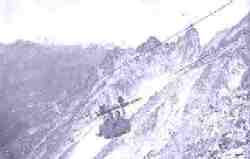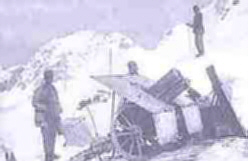
Ossuary and Chapel at Passo Tonale
Contains Remains of 800 Fallen of Both Sides
Of the few passes across the old Austro-Italian border, Passo Tonale at 1883 meters (6157 feet) is considered the great western approach into the Trentino, or from an Austrian point of view, into the lowlands of north central Italy. The only other international crossing is the Passo Stelvio/Stilfer Joch at 2760 meters (9025 feet). With its snowbound slopes and endless switchbacks, Stelvio also borders Switzerland, an invitation to further troubles in an already complex war. Beyond Tonale and Stelvio, at best, in mid-summer, are a few saddles with stable ice and snow or rocky goat trails.
The strategic value of Passo Tonale is greatly magnified when the terrain on each side is considered, the highest peaks of the Great War's entire Alpine front. The mighty Ortler range to the north rises as high as 3905 meters (12,770 feet). To the south are the Adamello and Presanella ranges with similar peaks and vast glaciers. In 1915 the summer meadows of Passo Tonale were no man's land. The surrounding ridges and summits would have to be occupied, observation posts and defenses manned- in all seasons. The warfare to control these ranges is legendary. [1]

Austro-Hungarian Reservists at the Presanella
Passo Tonale was well defended on both sides by fortresses, wire and trenches in-depth, mobile batteries and nearby garrisons. Along this frontier were each alpine nation's finest mountain troops, the Kaiserjager and Alpini. They were supplemented by Italian and Austrian reservists.[2] The regulars would eventually be siphoned off to more critical battles and fronts, the burden of defense being held increasingly by "die alte Tiroler" or "la Terrible," army nicknames for the reservist. The most formidable defenses for either side were the previously mentioned natural obstacles of glacier, cliff and endless craggy peaks. To move an army only one pass could be considered. All efforts would have to focus on Tonale Pass if a breakthrough were to take place.
During the Great War there would never be the manpower from either side to attempt break through this strategic pass, except once, in 1918. On the 13th of June, Austrian Archduke Peter would lead two divisions [including the 22nd Gebirgsbrigade, and local men in the 1st Landesschutzen Regiment, known since 1917 as Kaiserschutzen] in Operation Avalanche. This opportunistic diversion attempted to draw attention from two much larger Austrian offensives against the Piave River line and the Altipiano, centering on Monte Grappa. What would have happened if opportunity had been with the Austrians at Tonale is not known, as all effort, reserves and support were firmly focused to the east. Aktion Lawine failed miserably due to impossible terrain, undermanned units, meager supplies and determined Italian resistance. In hindsight, these two divisions might have made a critical difference in the Grappa or Asiago sectors, where similar Austrian offensives failed. The final action seen at Passo Tonale was the Italian pursuit of retreating Austrian forces, down the Val di Sole in November of 1918. Austrians from the Asiago/Val Sugana area and Trento were cut off and captured, along with great amounts of abandoned weapons and material.

Italian Cable Transport
|

A-H Artillery at Presanella
|
Today Passo Tonale is known for its outdoors activities such as skiing, hiking, wildlife observation and mountaineering. Smooth highway links the cultures of northern Italy and the southern Tyrol, who have honored the fallen of this war with a chapel/ossuary on Tonale Pass itself, and a rock and iron cairn above the pass. At the notch called Passo Paradiso skiers and hikers can pause a moment to consider the "Monument to Brotherhood" and past sacrifices in such a beautiful setting.
Notes
1 After May of 1916, the Adamello range was firmly in the hands of the Italian Alpini. Across the Val di Genova, the Presanella range would remain in Austrian control until the great retreat of 1918. Both ranges witnessed continuous warfare in raids and reconnaissance at high altitude and eternal snow. Warfare in the Ortler range was as intense, involving small unit battles, artillery duels and forward observers- often over 12,000 feet.
2 Austrian militia was composed of men under 19 years of age or over 42, and was found in two forms: the Standschutzen- reservists organized into local units and the Landesschutzen- a local militia, considered defensive in nature, but used across the Alpine front on many offensives. The Italian Alpini reservists were of a similar nature, all over 40 years old.
|








